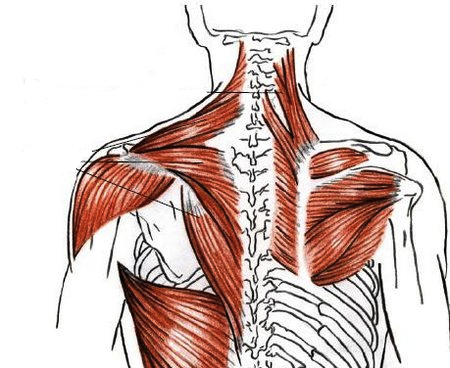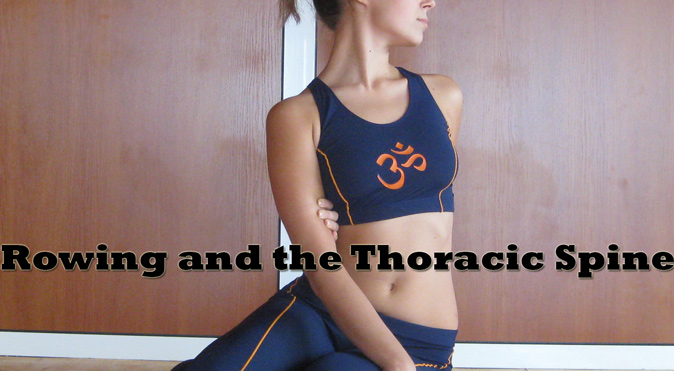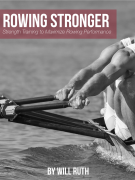Main Takeaways
- With its unique demands as a seated sport, rowing requires an aggressive mobility regimen to improve performance and decrease pain and risk of injury.
- Learn how to effectively target these problem areas with a combination of self-manual therapy, dynamic stretching, and static stretching for improved performance and longevity in the sport.
- Restricted thoracic spine mobility is common among rowers and can lead to scapular and spinal problems resulting in shoulder, elbow, back, and neck pain or injury.
For most athletes, practicing and competing in their sport is a daily break from the usual routine of sitting necessitated by the lifestyle of a student or desk-bound employee, but not so for rowers. While mobility work is important for all athletes, without dedicated attention to specific target areas, rowers can develop severe mobility restrictions that can decrease performance and lead to both short-term and long-term pain or injury.
First, we should understand broadly what “tightness” is and why mobility becomes restricted. “Tightness” has less to do with the structure of a muscle, and more to do with nervous system feedback, as very few people have muscles that are inherently too short for their skeletons. True structural problems in muscles occur when a muscle is torn or artificially kept in a shortened position for an extreme amount of time, such as an arm kept in a sling for 6-8 weeks. Instead, when someone says, “my _____ is tight,” what they’re really saying is, “my nervous system recognizes my instability in a compromised position and will not allow me to reach that point.”
The important takeaway is that end-limit flexibility is not the be-all-end-all to the mobility issue. Pure flexibility does not necessarily equate to stability, which is often the real reason movement is restricted. If you cannot support or stabilize yourself in a given position, the nervous system will continue to restrict range of motion to keep you out of that position. You also need to gain strength and stability in those flexible positions, or your flexibility on the yoga mat won’t carry over to the boat. This is done with strength training and disciplined attention to technique and posture during training. Every flawed stroke pulled is another that needs to be un-done and corrected before a new motor pattern can take place. Steady state training is a great way to train for postural and technique improvements at lower intensities. Simply row or erg until your form breaks down, rest, do some of the mobility work, and then start the next piece. Changing a technique or habit is painstaking, but well worth it to achieve greater performance, longevity in the sport, and decreased chance of injury.
Many rowers have mobility problems that restrict their ability to fully compress in the catch position or to get adequate torso angle and reach on the recovery. Rowers who bend excessively at the lumbar spine, round excessively in the mid and upper back (hunchback posture), or lose control at the catch resulting in inconsistent blade placement are common displays of mobility restrictions. These are common errors that frustrate coaches and rowers alike. It is helpful to know whether this error is caused by technique or an underlying structural problem preventing the rower from even being able to achieve the correct position.
Each article in this series will detail a different target area where rowers are particularly susceptible to mobility restrictions that decrease both short and long-term performance as well as health.


Restriction: Thoracic spine
Location: Mid back, vertebra T12 to T1
Muscles: The Thoracic spine includes the scapular muscles (supraspinatus, infraspinatus, teres major/minor), posterior deltoid, rhomboids, lower/middle trapezius, and latissimus dorsi muscles. While these muscles are used in every rowing stroke, rowers rarely reach full thoracic extension and many of these muscles under-develop without extra training. Rowers who row with a more rounded mid-back will usually exhibit greater restriction.
Test: Easy thoracic spine mobility test. If you can’t maintain contact between your hand and low back while reaching overhead with the other arm (keep it straight), there is a restriction.
Rowing fault: Hunchback posture, inconsistent handle heights, over-reaching at the catch.
Explanation: Restriction of these muscles most often displays as a rounded upper back, referred to as thoracic kyphosis or hunchback posture. If a rower is severely restricted and cannot reach thoracic extension or even maintain a neutral thoracic spine, this can cause uneven handle heights and difficulty with a “soft hands” approach at the catch, as rowers will naturally round further at the catch, making it more difficult to smoothly place the blade in the water. This also may look like overreaching, but it is really just what the rower perceives as a neutral spine because neutrality feels like extension to them. Finally, hunchback posture puts great stress on the anterior side of the spine, compressing discs and possibly causing damage or herniation to the thoracic vertebrae.
The Fix: Start by foam rolling broadly over the mid back. Do not roll on the lumbar spine or the neck. Roll both up and down the middle of the back as well as on the sides of the back, by the latissimus dorsi. After a few broad strokes up and down the back, begin at the bottom of the mid back and hinge up and down over the foam roller, moving up one vertebra at a time. Remember to not do this on the lower back or upper back. Further self-manual release work can be done with a lacrosse or tennis ball if you find one particular spot of tightness, commonly referred to as a trigger point. “The Peanut” is of great use for self-manual therapy on the thoracic muscles, as is a Theracane in my personal experience. With any specific trigger point work, take special care to avoid rolling directly over vertebrae or bones, as this will cause pain. Once you have worked through the thoracic spine, move on to the stretching shown in the video [timestamp 1:43].
Strengthening: The strict overhead press, face pull, Y-W-T raise, pull-up, and front squat will improve the strength and postural endurance of the scapular and postural muscles of the mid back and shoulder region. The Sots Press is also a useful activation and strengthening exercise, as seen in the mobility video. Strict attention to form to keep shoulder blades depressed and externally rotated, also referred to as “packed” or “back and down,” is essential.
In order to enact significant, lasting change, a dedicated comprehensive program that involves all modalities is critical. I recommend focusing on one problem area at a time, at least one 10-15 minute session per day. Spending 20 minutes a day working on mobility for 2-3 weeks while watching a TV show, for instance, is a great way to progress toward full function. Foam roll, perform self-manual release on specific trigger points, and stretch, then make sure to perform additional strengthening exercises while implementing proper form into your rowing and erging training. Also, be cognizant of posture throughout the day. Many times, those with thoracic restrictions will spend much of the day hunched over when standing or sitting. Once full function is achieved, mobility can be maintained simply by performing daily activities from that now-strengthened position that your body has adopted as a normal position.
Parts 2-4 are already available on www.RowingStronger.com, and deal with the Hip Flexors, the Glutes, and the Ankles. A free mini e-book guide is also available for download there too.
If you liked this, check out Will’s e-book and companion DVD, Rowing Stronger: Strength Training to Maximize Rowing Performance, available in the Rowperfect store. More information and a free chapter preview are available at www.RowingStronger.com/book.
Will Ruth is the strength coach for the Western Washington University men’s club rowing team. A former rower, Will has his bachelor’s degree in kinesiology and is an NSCA Certified Strength & Conditioning Specialist as well as USA-Weightlifting Level 1 certified. Learn more about Will and strength training for rowing in his guest appearance of Rowperfect’s Rowing Chat podcast.







This Post Has 2 Comments
Rowing Stronger looks really promising – I’m looking forward to reading it!
My favorite Ed McNeely quote is “The only thing machines (weights) are good for is melting down and turning into barbeques.”
Also another quote I forget from who: “Before you work on strength endurance, gain some strength to endure.”
Great quote, Camron! Hope you enjoy Rowing Stronger.
“Strength endurance without strength is just getting better at being weak”
Strength Coach Will